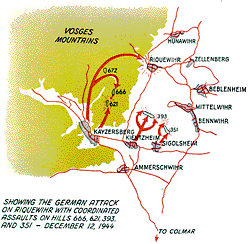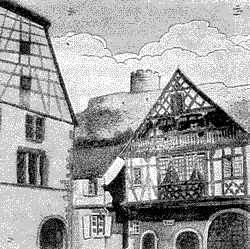|
|
|
|
| Throughout the next two days heavy artillery and mortar fire covered our area as the
Germans showed themselves determined to seize these vitally important hills. Shells
crashed down on the house tops in Riquewihr, along the communication lines to the rifle
companies up front and shook the high ridges that we were trying to defend. Each artillery
concentration was followed up by an immediate infantry attack, but each enemy assault was
hurled back as the men stubbornly held their ground. On the night of the 11th of December
the 3rd Battalion relieved the 1st Battalion, which in addition to having lost a company
had suffered heavy casualties. Upon the completion of this relief the 1st Battalion moved
back to Riquewihr. Throughout the 11th of December reports were received of increased vehicular activity in far off Colmar. After dark that night and throughout the early morning hours of the 12th, those of us on the forward hills could hear increased vehicular activity — tanks grinding along the roads and the clogging of horses' hoofs in Kientzheim, Ammerschwihr and Kaysersberg. Simultaneous with the attack on Riquewihr another attack was launched against the rifle companies on Hills 393 and 621, striking with the greatest fury at Company F. Grimly the men fought off the onslaught, knowing that a battle was also raging in the rear. Enemy pressure continued throughout the remainder of the 12th. Early the next morning some of the original force that had attacked Riquewihr attacked Co. F's Command Post from Hill 666 in the rear. Savage fighting raged for two hours with friendly mortar and artillery shells crashing down on every side of the F Company men before the assault was repulsed. Although the enemy had been decisively routed after each assault, his determination to continue attacking was not lessened. During the night of the 13th the skyline around Hill 393 was particularly brilliant as the enemy threw in one of the heaviest artillery concentrations of the war. The shells came crashing in just after an Engineer outfit had taken over E and G Companies' positions. A savage German infantry assault followed the artillery barrage, resulting in the capture of one Engineer platoon, heavy casualties and loss of the hill. Although battle weary and tired, the men of E and G Companies returned and fought their way back up the hill. Aided by two M4 tanks they succeeded in retaking all but a small pocket on the very summit by darkness of the 14th. From the 14th to the 17th I, K and E Companies participated in continuous local attacks and counterattacks against the unceasing efforts of the Germans to establish and reinforce strong points on the top of Hills 351 and 393. Over on Hill 621, F Company was engaged in similar activity. The enemy assaults never seemed to let up as the Germans remained determined to gain the highly sought ground; yet we fought them to a standstill. Gradually the offensive was taken away from the fanatically charging enemy. Early in the afternoon of the 17th of December, F and G Companies, supported by a company of hard-hitting, French manned Sherman tanks from the 5th French Armored Division, attacked the fortress town of Kientzheim. Moving down the forward slope of the saddle between Hills 393 and 621 across open vineyards, the tanks and infantry advanced under heavy artillery, self-propelled and anti-tank fire. The tanks sped to the only entrances to the town — one on the east side and, one on the west side — and entered the town as the men from F and G Companies, unable to move with the speed of the tanks, advanced over the exposed terrain and crossed a moat protecting the northern approaches to the Thirteenth Century citadel. In less than an hour organized resistance ceased with more than 100 prisoners captured, including a miscellaneous collection of loaded supply wagons and staff cars. Mopping up of isolated resistance continued until the early morning hours as the spasmodic crackle of small arms echoed through the walled Alsatian village. Late at night enemy tanks just outside the town continued to send shell after shell crashing into the settlement. Early the next morning more than 600 rounds an hour of mixed artillery poured in, but no counterattack developed. Kientzheim remained ours. Meanwhile the 3rd Battalion in attempting to attack Sigolsheim had run into heavy small arms fire on Hill 351 and was unable to move armor support up the muddy slopes of the hill to press their attack. Sigolsheim remained in German hands. At eight o'clock on the 18th of December, G Company, with the same French armor,
advanced on Kaysersberg across a one kilometer wide, vine covered flat patch of ground. As
the troops left the west gate of Kientzheim three enemy tanks opened fire After dark the French armor headed for Ammerschwihr. F Company was marched from Kientzheim to its assistance. Finding the bridges across the swollen stream between Kientzheim and Ammerschwihr destroyed, the company was forced to march by way of Kaysersberg through the rain drenched darkness. Long before daylight the men of Company F joined the French tanks and moved in on the burning and shell flattened town against light opposition. Late in the day we were relieved by elements of the 3rd Infantry Division. Kientzheim, Kaysersberg and Ammerschwihr, the towns from which the enemy had mounted his entire offensive, were completely occupied. Few of us will forget the long march back to Riquewihr over the ground we had fought so long and hard to hold and the feeling of relief that at last a rest was in store for us. Little did we realize at the time the importance of our actions-how much we had contributed toward checking the attempts of the Nineteenth German Army to cut off our division and close the St. Marie Pass. Yet, months later when the President of the United States awarded the 2nd Battalion, which had been on position continuously, the Distinguished Unit Citation, no one denied that it had been well earned.
|
|
Copyright © 1945, 1998 141st Infantry Regiment
Association. |


 between them and their objective. For 20 minutes a
tank battle raged; all three German tanks were knocked out by the French tanks, and the
outskirts of Kaysersberg were reached by eleven o'clock. Inside the town the tempo of
battle was reduced to a systematic house to house fight with the American infantry and
French tanks overcoming resistance in almost every house in the face of heavy bazooka and
machine gun fire. Late in the afternoon the heaviest opposition was encountered in a
fortified strongpoint in the heart of the city. Finally, after holding out for two hours,
the enemy garrison surrendered, yielding one German Colonel complete with his staff and
approximately 60 SS and Gestapo troops.
between them and their objective. For 20 minutes a
tank battle raged; all three German tanks were knocked out by the French tanks, and the
outskirts of Kaysersberg were reached by eleven o'clock. Inside the town the tempo of
battle was reduced to a systematic house to house fight with the American infantry and
French tanks overcoming resistance in almost every house in the face of heavy bazooka and
machine gun fire. Late in the afternoon the heaviest opposition was encountered in a
fortified strongpoint in the heart of the city. Finally, after holding out for two hours,
the enemy garrison surrendered, yielding one German Colonel complete with his staff and
approximately 60 SS and Gestapo troops.